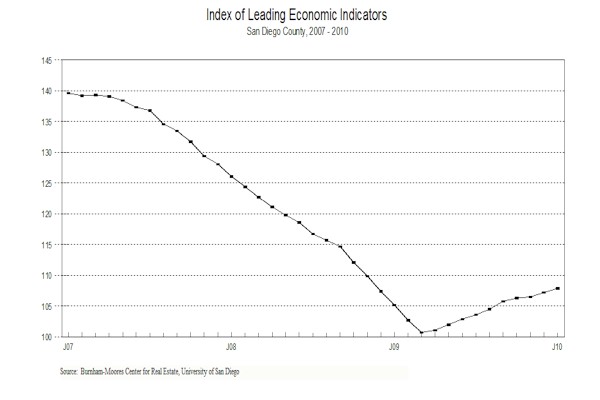|
Home
Leading Economic Indicators
Up in January
Note:
The tentative release date for next month's report is March 25.
February 25, 2010 -- The University of
San Diego's Index of Leading Economic Indicators for San Diego County rose 0.6
percent in January. Leading the advance was a strong positive move in initial
claims for unemployment insurance. There were also solid increases in building
permits, local stock prices, help wanted advertising, and the outlook for the
national economy. The only component to decrease was local consumer confidence.
With January’s increase, the USD Index has now advanced for 10 months in a row.
 |
Index of Leading Economic
Indicators
The index for San Diego County that includes the
components listed below (January)
Source: University of San Diego |
+ 0.6 % |
 |
Building Permits
Residential units authorized by building
permits in San Diego County (January)
Source: Construction Industry Research
Board |
+ 0.96% |
 |
Unemployment Insurance
Initial claims for unemployment insurance in San Diego County, inverted,
estimated (January)
Source: Employment Development Department |
+ 1.76% |
 |
Stock Prices
San Diego Stock Exchange Index (January)
Source:
San Diego Daily Transcript |
+ 0.52% |
 |
Consumer Confidence
An index of consumer confidence in San
Diego County (January)
Source:
San Diego Union-Tribune |
- 0.42% |
 |
Help Wanted Advertising
An index of online help wanted advertising in
San Diego (January)
Source: Monster Worldwide |
+ 0.50% |
 |
National Economy
Index of Leading Economic Indicators (January)
Source: The Conference Board |
+ 0.56% |
There is no change in the previously reported outlook for the
local economy. A bottom in terms of economic activity is likely in the first
half of 2010, if it hasn’t already occurred. Unlike the national economy, where
the Gross Domestic Product is reported quarterly as a gauge of the strength of
the economy, the only measures that come out frequently at the local level are
the employment and unemployment numbers. The problem is that employment is
typically a lagging indicator, as firms usually wait until they are sure that a
recovery has taken hold before they make the big commitment to add permanent
staff. The situation will probably be more difficult in this recovery as many
firms took steps to be much more efficient and are unlikely to hire back as many
employees as they let go during the downturn.
Highlights:
Residential units authorized by building permits began the year like it
ended 2009, with a gain. The 282 residential units authorized in January were
low by historic standards, but were much better than the 87 that were authorized
in January 2009, the first time ever that fewer than 100 units had been
authorized in a month. . . Both the labor market variables continue to rebound.
Initial claims for unemployment insurance dropped during the month, which
is very positive news because January is usually the worst month of the year in
terms of initial claims as retailers lay off their seasonal staff after the
holidays. On the hiring front, help wanted advertising was up for the
third month in a row, although that was due primarily to seasonal adjustment, as
January is also typically the worst month of the year for that component. The
employment and unemployment numbers for January have not been released as of the
writing of this report. . . The trend in local consumer confidence turned
negative for the first time since last March. As has been mentioned before, the
USD Index uses a weighted moving average to smooth out the month-to-month
fluctuations in the individual components. While the actual level of the
consumer confidence index was up, the seasonally adjusted moving average was
down. . . The methodology used also came into play with local stock prices.
The value used for local stocks is the average daily close for the entire month.
So even though local stocks ended the month lower than they started it, the
average for the month as a whole showed an increase. . . There continues to be
good news on the national economy as the national Index of Leading Economic
Indicators was up for the tenth month in a row. Unemployment and job loss
remain high at the national level, although there is hope that job growth will
resume in the coming months.
January’s increase puts the USD Index of Leading Economic
Indicators for San Diego County at 107.9, up from January’s revised reading of
107.2. Changes in building permits for December and for the national Index of
Leading Economic Indicators from July on led to a revision in the previously
reported change for July and in the level in the Index for every month going
back to July. Please visit the Website address given below to see the revised
changes for the individual components. The values for the USD Index for the last
year are given below:

For more information on the University of San Diego's Index of Leading
Economic Indicators, please contact:
|